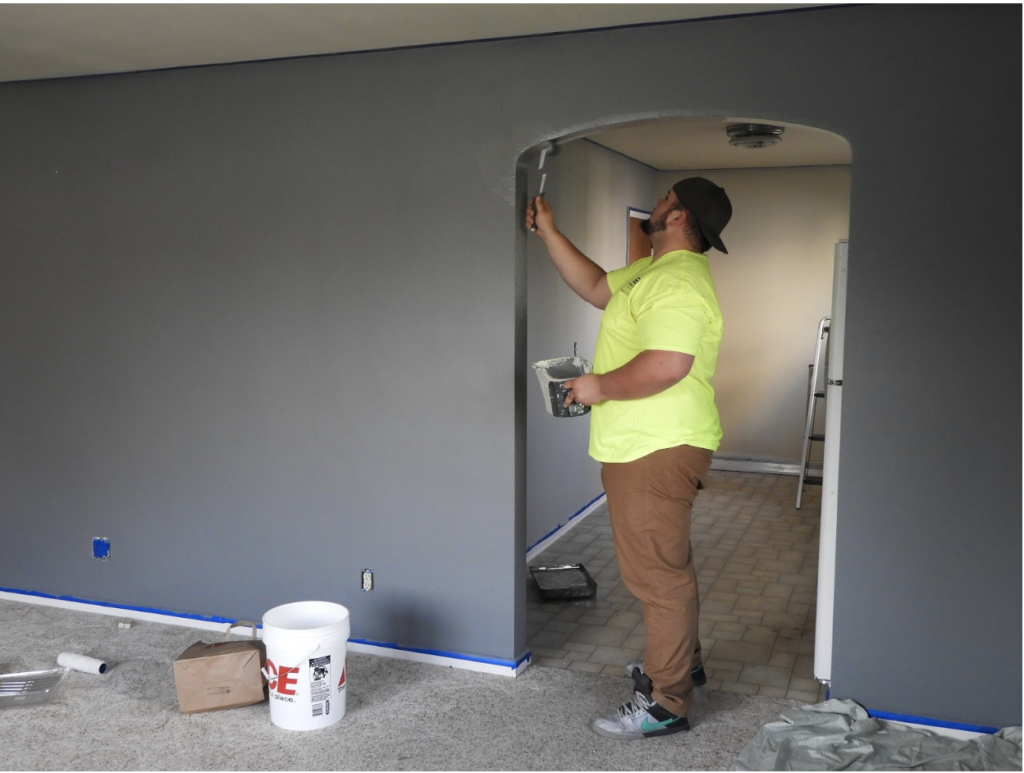5 Tips to Help You Choose the Right Color When Repainting Your Home
How do you begin to narrow the practically limitless possibilities of interior wall paint? It may be incredibly overwhelming to even begin the process of finding your perfect color and talented painters to refresh your interior walls because it is a process. It helps to begin by narrowing your color focus.
First, what’s your vibe? Retro, classic, trendy, bold, sophisticated, subdued? Decide what you’d like the room to feel like when done. Before you choose your wall color scheme, consider the effect your final choice will have on the overall appearance of your room.
DIY painting is an inexpensive way to quickly revamp the mood of your living space. Since walls are the most dominant color in the room, it pays to take your time before making a final decision.
The good news is that today’s paint options have better durability and more finish options, such as flat, satin enamel, gloss and semi-gloss than in years past. Many paints resist mildew, stains, moisture and can even be scrubbed – perfect for growing families or high-traffic areas.
Here are five factors to consider when exploring your options for the “right” interior paint color.
1. Find Inspiration In Things You Love
Make your paint palette relatable to you and your preferences when you stick with colors and combinations found in things you love to inspire your selections.
For example, someone with a preference for the rich colors of fall may look to the colors of pumpkins or apples, or the reds, oranges, and yellows of fall leaves, to bring natural colors indoors and create a comforting space with a personality that’s reflective of you.
You might bring a beloved item, such as an heirloom quilt or painting, to the paint store to create a custom blend to match any specific color you’re fond of. Using colors found in items you already own and cherish is a safe bet and one way to land on meaningful paint colors you’re far less likely to regret.
2. Consider Coordinating Colors
Of course, it’s important to also think about choosing colors that pair well overall with the colors in your adjacent rooms, appliances, kitchen counters or backsplashes, or bathroom fixtures. Before you pick up a paintbrush, it is a super smart move to map out a plan with these adjacent colors in mind.
You can easily change out wall plates, area rugs, and light fixtures, but it’s much more difficult, and expensive, to swap out your bathtub or flooring. Unless you’re planning to buy possibly expensive new accessories, remember to keep in mind the colors in your furniture and artwork that’s already in the room.
So be sure to look for colors that compliment or blend with your overall décor and existing fixtures and match your taste. Painting a room can change how a room feels so be sure you appreciate the new look.
3. Create An Illusion
Contrasting light and dark can help you create a visual illusion in your home’s space. Lighter, pale colors are the easiest and cheapest way to help liven up the smallest of rooms and help them feel larger. Conversely, dark, rich colors can help scale down a larger space or be a perfectly chic shade for a home library.
Painting a ceiling darker color than the walls can trick the eye and visually lower a high ceiling, ultimately giving an illusion of a serene, cozier space if that is the look you are going for.
If your house has a “great room” layout, where living spaces open up to one other, new paint needs to work with those adjacent areas too. Perhaps an array of muted Terra cotta hues will pair nicely and bring beautiful harmony from one interior area to another.
4. Test Drive Your Top Color Choices
Before making a major commitment, small color chips and swatches are a great way to get a first impression of color in your room. Put color chips on a poster board and move it around your room to see the potential colors in corners, near windows, up high, and down low. Paint colors look different when viewed in different light conditions.
Generally, colors on paint chips look darker when applied to your walls so if you’re slightly worried a particular shade might be a bit too dark, consider going a shade lighter. Some paint brands sell large stick on paint samples for you to get an even better idea of whether you love the color.
Some paint retailers also offer online room visualizers that can help you get a big-picture idea of a particular paint color in action and whether you want to order a sample can for a larger test. The good news is, paint is relatively easy to change so if you don’t like a sample, you can move on to one you prefer.
When you think you’ve got your paint colors narrowed to a couple of choices, ask for samples. Then paint a 2’ by 2’ area on the actual wall, allowing it to thoroughly dry. This is important since all paint dries darker than it appears when wet. Evaluate the paint in natural light because some colors, like peach, for instance, can appear pinkish in extreme natural light.
Live with the sample colors on your wall for at least a week so you can view the colors and undertones in various lighting conditions. Some paint will look great in sunlight and you may hate it in the artificial light in the evening. Better to find out how you feel before you paint the whole room!
5. Think About Re-Sale Potential
It’s true that color is extremely important, and can put prospective home buyers at ease. While you might really love your lime green or magenta dining room walls, consider repainting with more understated, or neutral, colors if you’re thinking of re-selling your home in the near future.
It’s important to remember that, while neutral colors usually blend well with most décor, they don’t have to be boring or dull. Some neutral colors are extremely versatile and a beautiful choice for practically any style of home décor.
A neutral color palette can create a better first impression of your home, and help potential buyers really envision themselves in your space. Outdated wall colors (like the deep chocolate brown so popular in the 70s), dinged-up or grimy walls, or wild paint choices (think neon colors), can be instant turn-offs for would-be buyers.
Reimagine your home from the vantage point of potential buyers. Traditional beiges or browns, taupes, oatmeals, and grays are inviting hues for living rooms and pleasing to nearly every taste.
Slate blue or greige can be stunning, upbeat choices for cozy kitchen and dining areas. And bedrooms/bathrooms in soft blues or grays convey calm, comfort, and peacefulness, especially good choices for resale purposes.
It’s important to remember that colors that look fresh and “move-in ready” could increase your home’s sales price. If you haven’t painted your walls in ages, take time to invest in a fresh coat of neutral paint and transform your space before you list your property. If you aren’t planning to sell your home, go wild and love whatever color you want!
Conclusion
 Whatever colors in the rainbow of hues, shades, and tones you ultimately decide on, choosing the right paint color doesn’t have to be daunting. Simply take things step-by-step, be sure to align the colors with your personal style and objectives, then enjoy decorating with color.
Whatever colors in the rainbow of hues, shades, and tones you ultimately decide on, choosing the right paint color doesn’t have to be daunting. Simply take things step-by-step, be sure to align the colors with your personal style and objectives, then enjoy decorating with color.
As a collaborative interior design firm, we help busy homeowners save time, avoid design missteps and reduce overwhelm. We design living spaces that evoke emotion and enhance each project with custom window treatments because we feel they provide the ultimate finishing touch to our designs.
To learn more about our process and to see if we are a good fit, we invite you to take advantage of a complimentary discovery call. Give us a ring at (513)-409-3759
Your partner in design
Team Ydp

Decorating or Refreshing Your Home?
Download our COMPLIMENTARY checklist and get access to our 7 Step Process to Decorate in Stages, Stay on Budget & Reduce Overwhelm.
Thank you for requesting our checklist head over to your email to get instructions on how to access it now!
We hate spam as much as you do we promise not to share any of your information...







